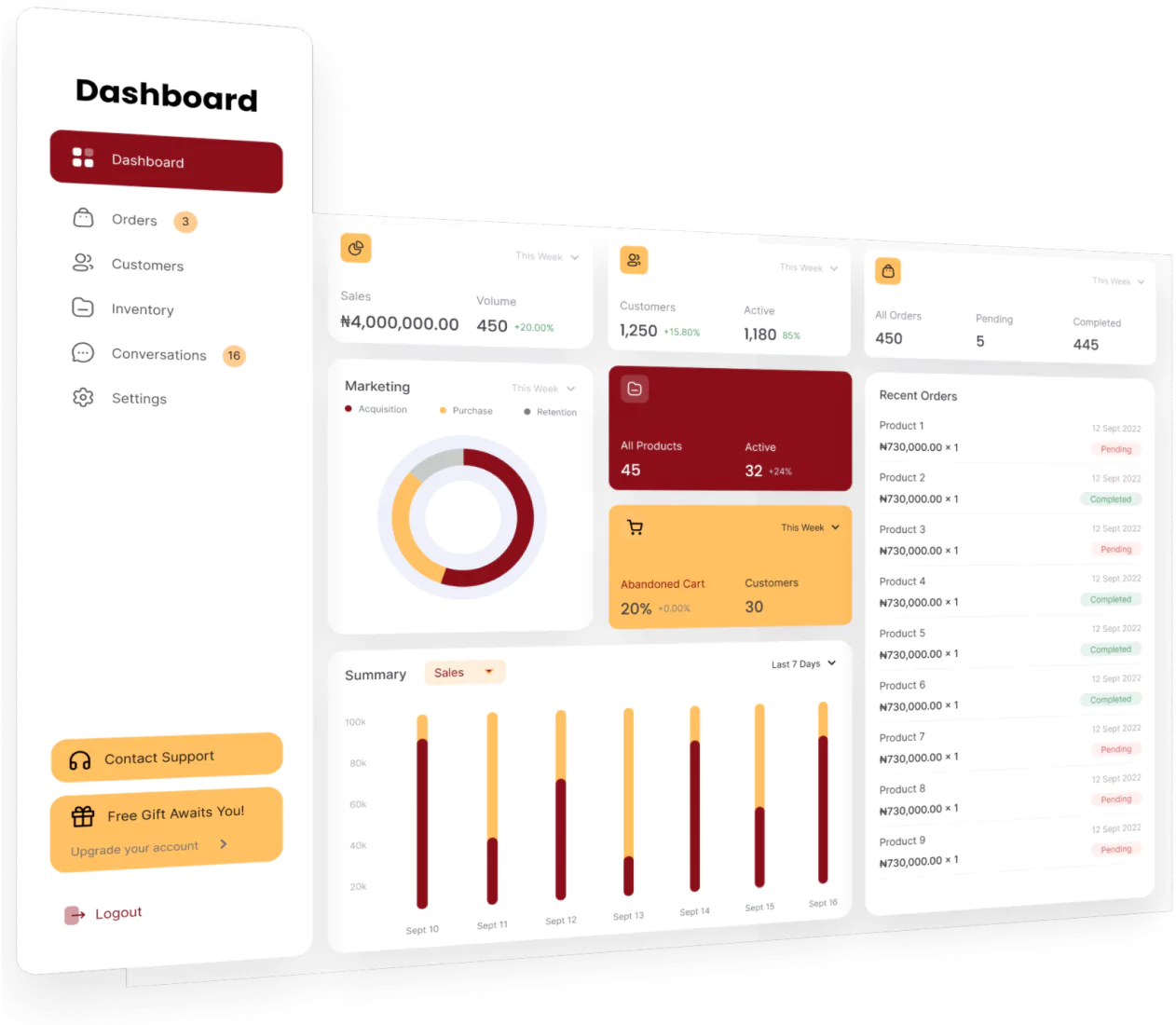Imagine accurately predicting customer demand, reducing waste, cutting costs, and maximizing profitability. AI demand forecasting uses advanced machine learning and data analytics to generate precise predictions, helping companies stay agile and ahead of market shifts.
Without accurate demand forecasting, businesses face stock shortages, excess inventory, and missed revenue opportunities. Traditional forecasting methods often struggle to adapt to sudden market changes, making it difficult to respond effectively.
AI driven forecasting overcomes these limitations by analyzing vast amounts of data in real time, enabling smarter decision making and operational efficiency.
Want to know how AI demand forecasting can give your business a competitive edge? Basahin pa upang tuklasin kung paano binabago ng teknolohiyang ito ang pamamahala ng imbentaryo, pinapahusay ang mga supply chain, at nagtutulak ng tagumpay sa negosyo.
Key Takeaways
|
Table of Contents

What is AI Demand Forecasting?
AI demand forecasting is the use of artificial intelligence and machine learning to predict future customer demand based on historical data, market trends, and real time insights.
Unlike traditional forecasting methods that rely heavily on manual analysis and static models, AI-driven forecasting continuously learns and adapts to changing patterns, making predictions more accurate and reliable.
By leveraging advanced algorithms, AI demand forecasting helps businesses optimize inventory levels, reduce waste, and improve supply chain efficiency.
This technology enables companies to anticipate demand fluctuations, minimize stock shortages or overstocking, and make data driven decisions that enhance profitability.
Need to know!
AI-powered demand forecasting helps businesses predict customer needs more accurately. With Hashy AI from HashMicro, you can optimize inventory, reduce waste, and make smarter supply chain decisions.

Get a Free Demo Now!
How AI Demand Forecasting Works
AI demand forecasting analyzes vast amounts of historical data, market trends, and external factors to accurately predict future demand. Using machine learning algorithms and forecasting tools, the system identifies patterns, detects seasonal trends, and adapts to real-time changes in consumer behavior.
The process typically begins with data collection from various sources, such as sales records, customer behavior, economic indicators, and external factors like weather conditions.
AI powered forecasting tools then process this data, apply predictive models, and generate insights that help businesses make informed inventory, production, and supply chain management decisions.
By continuously learning and refining its predictions, AI demand forecasting, supported by advanced forecasting tools, enables companies to minimize stock shortages, reduce excess inventory, and respond proactively to market fluctuations.
The Differences Between AI Demand Forecasting and Traditional Methods
Traditional forecasting methods rely on historical data and manual calculations, often struggling to adapt to market changes.
In contrast, AI demand forecasting leverages real time data and machine learning for more accurate and dynamic predictions. The table below highlights the key differences between these two approaches.
| Aspect | AI Demand Forecasting | Traditional Forecasting Methods |
|
Data Processing |
Analyzes large datasets in real time using AI algorithms. |
Relies on historical data and manual calculations. |
|
Accuracy |
Continuously learns and improves prediction accuracy. |
Prone to human error and limited by static models. |
|
Adaptability |
Adjusts forecasts dynamically based on real-time trends. |
Struggles to adapt to sudden market changes. |
|
Speed |
Processes and updates forecasts instantly. |
Time-consuming and requires frequent manual updates. |
|
Decision-Making |
Provides data-driven insights for proactive strategies. |
Often based on assumptions and past experiences. |
|
Cost Efficiency |
Reduces excess inventory and stock shortages. |
May lead to overstocking or lost sales due to inaccuracies. |
By understanding these differences, businesses can make informed decisions on adopting AI-powered forecasting tools to improve efficiency, reduce costs, and stay competitive in a rapidly evolving market.
The Benefits of AI in Demand Forecasting

AI driven demand forecasting is transforming how businesses predict and manage inventory. By leveraging machine learning and real-time data analysis, AI enhances forecasting accuracy, optimizes supply chains, and reduces operational risks. Below are some key benefits of using AI in demand forecasting.
- Improved forecast accuracy: AI processes vast amounts of data and identifies complex patterns that traditional methods often miss. This leads to more precise demand predictions, helping businesses reduce stock shortages and overstocking.
- Real time data processing: Unlike conventional forecasting, AI continuously updates predictions based on real-time data, allowing companies to adapt quickly to market shifts and unexpected changes in demand.
- Enhanced supply chain efficiency: AI powered forecasting helps businesses optimize inventory management, streamline logistics, and improve supplier coordination, resulting in cost savings and better resource allocation.
- Risk reduction and better decision making: By analyzing external factors such as economic trends, weather patterns, and consumer behavior, AI demand forecasting minimizes risks and supports data-driven decision-making.
- Cost savings and increased profitability: With more accurate forecasts, businesses can avoid unnecessary inventory costs, reduce waste, and maximize revenue opportunities, ultimately improving overall profitability.
Challenges of AI in Demand Forecasting
While AI demand forecasting offers significant advantages, its implementation comes with challenges that businesses must address.
From data quality issues to high implementation costs, understanding these obstacles is crucial for maximizing the effectiveness of AI-driven forecasting. Below are some key challenges companies may face when adopting AI in demand forecasting.
1. Data quality and availability
AI demand forecasting depends on vast amounts of accurate and well-structured data. However, many businesses struggle with incomplete, outdated, or inconsistent data from multiple sources.
Poor data quality can lead to unreliable predictions, making it essential for companies to implement data cleansing processes, integrate reliable data sources, and ensure real-time updates.
2. High implementation costs
Deploying AI in finance requires significant financial investment, including advanced software, cloud computing infrastructure, and skilled personnel.
Small and medium-sized enterprises (SMEs) may find these costs challenging, making evaluating cost-effective AI solutions or phased adoption strategies to minimize initial expenses crucial.
3. Complexity in AI model training
AI systems do not deliver accurate predictions automatically; they require continuous training, fine-tuning, and validation to improve forecasting accuracy.
This process involves using historical and real-time data, testing various machine learning models, and adjusting parameters. Without experienced data scientists or AI specialists, businesses may struggle to optimize their forecasting models.
4. Integration with existing systems
Many companies rely on legacy ERP, AI inventory management, or supply chain systems that may not be compatible with AI-driven forecasting tools. Ensuring smooth integration often requires custom APIs, middleware solutions, or even system upgrades, which can be time consuming and costly.
5. Security and data privacy concerns
AI forecasting relies on vast amounts of sensitive business and customer data, prioritizing security and regulatory compliance. Unauthorized access, data breaches, or failure to meet data protection regulations can have legal and financial consequences.
Companies must implement robust cybersecurity measures, encryption protocols, and access controls to protect their data assets.

How to Implement AI for Demand Forecasting
Implementing AI for demand forecasting requires a strategic approach to ensure accurate predictions and seamless integration with existing business processes. Companies must follow several key steps to maximize the benefits of AI-driven forecasting.
First, businesses need to assess their data quality and availability. AI models rely on vast amounts of historical and real-time data, so it is essential to ensure that data is clean, structured, and comprehensive.
Next, selecting the right AI tools and forecasting software is crucial. Companies should evaluate solutions based on their ability to analyze large datasets, adapt to market trends, and integrate with existing inventory and supply chain management systems.
Once a suitable AI solution is chosen, businesses must train the AI model using relevant historical data. This step helps the system recognize demand patterns, seasonal fluctuations, and external factors influencing purchasing behavior.
After training, the AI system should be tested and refined continuously. By monitoring its performance and comparing predictions with actual demand, companies can fine-tune the model to improve accuracy over time.
Finally, businesses must ensure that AI forecasting insights are effectively used in decision-making. AI-generated forecasts should guide procurement, inventory management, and sales strategies, helping teams make proactive, data-driven decisions.
Simplify Demand Forecasting Process with HashMicro Software

Accurate demand forecasting is essential for businesses to maintain optimal inventory levels, reduce waste, and efficiently meet customer demand. However, traditional forecasting methods often involve complex calculations and manual data analysis, leading to inefficiencies and errors.
Hashy AI simplifies this process by automating demand forecasting with advanced analytics and machine learning.
With HashMicro’s Demand Forecasting Software, businesses can make smarter, data-driven decisions with ease.
Here are some key features that make forecasting more accurate and efficient:
- AI powered forecasting with Hashy AI: Leverage Hashy AI to analyze historical sales data, market trends, and external factors, ensuring precise demand predictions without manual intervention.
- Real time data synchronization: The system automatically updates inventory, sales, and supplier data, providing businesses with up-to-date insights to make informed decisions.
- Automated stock replenishment: Avoid stockouts and overstocking with an intelligent replenishment system that suggests optimal inventory levels based on demand patterns.
- Seamless integration with ERP Systems: HashMicro’s AI in ERP software integrates smoothly with accounting and supply chain management systems, streamlining the entire business process.
- Customizable forecasting models: Businesses can tailor forecasting models to match specific industry needs, whether in retail, manufacturing, or distribution.
- User friendly dashboards and reports: Interactive dashboards and automated reports provide clear, visual insights, helping management make data-driven decisions quickly.
By implementing HashMicro’s Demand Forecasting Software, businesses can eliminate guesswork, optimize inventory management, and improve overall operational efficiency. Ready to transform your forecasting process? Contact us today for a free demo!
Conclusion
AI demand forecasting has become a game-changer for businesses looking to improve accuracy, reduce costs, and optimize inventory management.
By leveraging AI-powered insights, companies can anticipate market trends, adjust supply levels proactively, and make data-driven decisions that enhance overall efficiency.|
With HashMicro’s AI driven Demand Forecasting Software, businesses can simplify this process through automation, real-time data analysis, and seamless ERP integration. Hashy AI powers the system and ensures precise demand predictions, helping you avoid stock shortages and excess inventory.
Take the next step toward smarter forecasting and greater efficiency. Try HashMicro’s free demo today and see how AI can transform your demand planning!

FAQ AI Demand Forecasting
-
How is AI used in financial forecasting?
AI tools help businesses identify future expansion opportunities and help ensure the financial viability of a business. Predictive analytics provides deep insights into various aspects like market trends, customer habits, etc., which help in accurate forecasting.
-
Can you use AI to predict stock market?
One of the most important features of AI is its ability to analyze historical data and detect trends. By processing large datasets, AI models can predict how stocks might perform based on past market behavior. However, stock prices can be volatile, and predicting them with complete certainty is nearly impossible.
-
How is demand forecasting done?
Demand forecasters attempt to do just that by using predictive analysis techniques to spin data about past and present sales into predictions of what customers will want in the future. But generating predictions is only the beginning.





































































